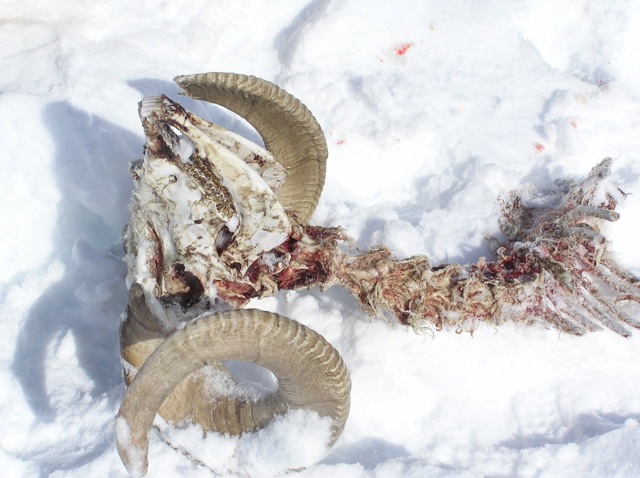Dall Sheep, Grizzly
Bear, and Wolf Capture Sessions
In
April 2006, we fitted six Dall’s sheep ewes with Telonics
TWS-3580 (GPS satellite) collars. The collared individuals
belonged to different family groups, and were all located
in the vicinity of Mount Goodenough (locally named Black
Mountain). We then captured four wolves in each of the
following areas: the Rat River valley and the Fish Creek
valley, for a total of eight wolves. One wolf in each pack
was equipped with a Telonics TWS-3580 collar, and the three
others were fitted with Lotek 3300SW GPS collars
(store-on-board models). Few months after the capture, we
lost contact with one of the wolves wearing a GPS satellite
collar, but we could retrieve and replace the collar in the
2007 session. In May 2006, seven grizzly bears (two males
and five females) were fitted with Telonics TWS-3680
collars.
In 2007, we recaptured four of the wolves to equip them
with new GPS satellite collars, and collared one additional
wolf as well. We are now monitoring nine wolves from three
different packs: the Rat River, Fish Creek, and Willow
River packs, which cover most of the study area. We also
equipped eight more grizzly bears with GPS satellite
collars (3 males and 5 females). It was decided in
collaboration with the local Renewable Resource Councils
that no Dall sheep would be collared in 2007.
For all the marked animals except the wolves wearing
store-on-board collars, partial locations are transmitted
every week through the Argos system. The remaining
locations will be obtained when we will retrieve the
collars from the field, after they fall from the animals’
neck through a programmed release mechanism attached to
each collar.
Mortality and Predation
Two of the
sheep unfortunately died during the course of summer 2006,
and their carcasses were retrieved at the bottom of a steep
slope. The sites were visited too late after the collars
have stopped moving, and the cause of the mortalities could
not be detected. The signal from one grizzly bear has also
stopped moving during the summer, relatively far outside
the study area, and the collar will be retrieved soon.
During our visits in the field in 2006, we discovered few
sheep carcasses throughout the range, and one appeared to
be a fresh predation case from wolves. Other carcasses were
too old to provide information related to the mortality
cause. Transects to find carcasses and investigations of
kill sites are planned during our field sessions in June
2007 and 2008. The analysis of grizzly bear and wolf diets
has not started yet, but we are actively collecting samples
in collaboration with ENR, GNWT.

Spatial Interactions
We are
already noticing a large overlap between the three species
range, particularly between grizzly bears and Dall sheep.
The deployment of additional collars on the animals
contribute to provide interesting insights about the
interactions between the three species, and further
monitoring will enable us to better understand their
dynamics. I am currently in the process of analysing the
available data and determining which spatial analyses will
yield greater insights. At this time, techniques of choice
will involve home range analysis, dynamic distances and
movements of the individuals, resource selection, overlap
between species and individuals, and multivariate
statistics.
Snow and Climate Monitoring
A weather station was erected in the study area in August
2006, and it is programmed to record temperature, relative
humidity, wind speed and direction, and barometric pressure
at regular intervals of the day. Snow surveys were also
performed in snowmobile in March 2006 by one team from Fort
McPherson (Lloyd Nerysoo, Norm Vittrekwa and Shawn
Vittrekwa), and one team from Aklavik (Ryan McLeod and
Larry Koe). Snow depth and habitat characteristics were
observed at different sites within the study area.
Traditional Knowledge Interviews
A Dall sheep local knowledge study was conducted in 2001 in
Aklavik and Fort McPherson (Shaw et al. 2005), and more
interviews with elders and knowlegeable users are planned
for July and August 2007. The interviews will complement
the knowledge acquired through other methods, and will
document precious knowledge of Gwich'in and Inuvialuit
elders and harvesters.